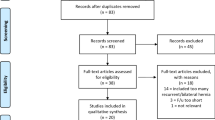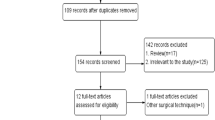Abstract
Background
Lichtenstein repair is standard practice for inguinal herniorrhaphy, but there is increasing public concern in the use of mesh and postoperative chronic pain. New mesh technology, such as the prolene hernia system, has a preperitoneal component to reinforce the myopectineal orifice aim to reduce the risk of recurrence and chronic pain. This meta-analysis compares outcomes using prolene hernia system versus lichenstein repair for inguinal hernias.
Methods
Randomized-controlled trials comparing prolene hernia system and Lichtenstein repair were identified using Embase, Medline, and published conference abstracts. Primary outcomes were recurrence and chronic pain. Secondary outcomes were mean operating time, composite complications, surgical reintervention, and time to normal activities. Odds ration and standardized mean differences were calculated.
Results
1377 hernia repairs were identified from a total of 7 trials. Mean follow-up was 12–91 months. There was no difference between the techniques for recurrence [pooled analysis odds ratio: 0.86 (95% CI 0.32–2.28); p = 0.76] and chronic pain [pooled analysis odds ratio: 1.00 (95% CIs 0.65–1.55); p = 1]. Prolene hernia system demonstrated a shorter time to return to normal activities [pooled weighted mean difference − 0.54 (95% CI − 1.07 to − 0.01); p = 0.04]. Other outcomes were similar in mean operating time, composite complications, and surgical reintervention.
Conclusion
Both prolene hernia system and Lichenstein repair appear comparable acceptable techniques for inguinal herniorrhaphy. Further longer-term studies of new mesh technologies will improve information available to surgeons and their patients.







Similar content being viewed by others
References
Lichtenstein IL, Shulman AG (1986) Ambulatory outpatient hernia surgery. Including a new concept, introducing tension-free repair. Int Surg 71(1):1–4
Bringman S, Wollert S, Osterberg J, Smedberg S, Granlund H, Heikkinen TJ (2006) Three-year results of a randomized clinical trial of lightweight or standard polypropylene mesh in Lichtenstein repair of primary inguinal hernia. Br J Surg 93(9):1056–1059
Beitler JC, Gomes SM, Coelho AC, Manso JE (2009) Complex inguinal hernia repairs. Hernia J Hernias Abdom Wall Surg 13(1):61–66
Lundstrom KJ, Sandblom G, Smedberg S, Nordin P (2012) Risk factors for complications in groin hernia surgery: a national register study. Ann Surg 255(4):784–788
Aasvang EK, Gmaehle E, Hansen JB, Gmaehle B, Forman JL, Schwarz J et al (2010) Predictive risk factors for persistent postherniotomy pain. Anesthesiology 112(4):957–969
Nienhuijs SW, Boelens OB, Strobbe LJ (2005) Pain after anterior mesh hernia repair. J Am Coll Surg 200(6):885–889
Hakeem A, Shanmugam V (2011) Inguinodynia following Lichtenstein tension-free hernia repair: a review. World J Gastroenterol 17(14):1791–1796
Lundstrom KJ, Holmberg H, Montgomery A, Nordin P (2018) Patient-reported rates of chronic pain and recurrence after groin hernia repair. Br J Surg 105(1):106–112
Olsson A, Sandblom G, Franneby U, Sonden A, Gunnarsson U, Dahlstrand U (2017) Impact of postoperative complications on the risk for chronic groin pain after open inguinal hernia repair. Surgery 161(2):509–516
Kurzer M, Kark AE, Belsham PA (2005) Open preperitoneal mesh repair for recurrent inguinal hernias. Hernia J Hernias Abdom Wall Surg 9(1):105
Gilbert AI, Graham MF, Voigt WJ (1999) A bilayer patch device for inguinal hernia repair. Hernia J Hernias Abdom Wall Surg 3(3):161–166
DerSimonian R, Laird N (1986) Meta-analysis in clinical trials. Control Clin Trials 7(3):177–188
Higgins JP, Thompson SG (2002) Quantifying heterogeneity in a meta-analysis. Stat Med 21(11):1539–1558
Jadad AR, Moore RA, Carroll D, Jenkinson C, Reynolds DJ, Gavaghan DJ et al (1996) Assessing the quality of reports of randomized clinical trials: is blinding necessary? Control Clin Trials 17(1):1–12
Pierides G, Vironen J (2011) A prospective randomized clinical trial comparing the Prolene Hernia System and the Lichtenstein patch technique for inguinal hernia repair in longterm: 2- and 5-Year results. Am J Surg 202(2):188–93
Dalenback J, Andersson C, Anesten B (2009) Prolene Hernia System, Lichtenstein mesh and plug-and-patch for primary inguinal hernia repair: 3-year outcome of a prospective randomised controlled trial. The BOOP study: bi-layer and connector, on-lay, and on-lay with plug for inguinal hernia repair. Hernia 13(2):121–129.
Magnusson J, Nygren J, Gustafsson UO, Thorell A (2016) UltraPro Hernia System, Prolene Hernia System and Lichtenstein for primary inguinal hernia repair: 3-year outcomes of a prospective randomized controlled trial. Hernia 20(5):641–648
Sanjay P, Harris D, Jones P (2006) Randomized controlled trial comparing prolene hernia system and lichtenstein method for inguinal hernia repair. ANZ J Surg 76(7):548–52
Nienhuijs SW, Rosman C (2015) Long-term outcome after randomizing prolene hernia system, mesh plug repair and Lichtenstein for inguinal hernia repair. Hernia 19(1):77–81
Kingsnorth AN, Wright D, Porter CS (2002) Prolene Hernia System compared with Lichtenstein patch: a randomised double blind study of short-term and medium-term outcomes in primary inguinal hernia repair. Hernia 6(3):113–119
Badjur N, Garg N (2015) Comparative Study of Prolene Hernia System and Lichtenstein Method for Open Inguinal Hernia Repair. J Clin Diagn Res 9(6):PC04–PC07
Currie A, Andrew H, Tonsi A, Hurley PR, Taribagil S (2012) Lightweight versus heavyweight mesh in laparoscopic inguinal hernia repair: a meta-analysis. Surg Endosc 26(8):2126–2133
Sajid MS, Leaver C, Baig MK, Sains P (2012) Systematic review and meta-analysis of the use of lightweight versus heavyweight mesh in open inguinal hernia repair. Br J Surg 99(1):29–37
Stoppa R, Petit J, Abourachid H, Henry X, Duclaye C, Monchaux G et al (1973) Original procedure of groin hernia repair: interposition without fixation of Dacron tulle prosthesis by subperitoneal median approach. Chirurgie; memoires de l’Academie de chirurgie 99(2):119–123
Kugel RD (1999) Minimally invasive, nonlaparoscopic, preperitoneal, and sutureless, inguinal herniorrhaphy. Am J Surg 178(4):298–302
Ugahary F (2001) The gridiron hernioplasty. In: Bendavid R, Abrahamson J, Arregui ME, Flament JB, Phillips EH (eds) Hernias of the abdominal wall: principles and management. Springer, New York, p 407
Willaert W, De Bacquer D, Rogiers X, Troisi R, Berrevoet F (2012) Open preperitoneal techniques versus Lichtenstein repair for elective inguinal hernias. Cochrane Database Syst Rev 7:CD008034
Lowham AS, Filipi CJ, Fitzgibbons RJ Jr, Stoppa R, Wantz GE, Felix EL et al (1997) Mechanisms of hernia recurrence after preperitoneal mesh repair. Traditional and laparoscopic. Ann Surg 225(4):422–431
Acknowledgements
The authors would like to thank Drs. Magnusson and Kingsnorth for providing further information and data for inclusion in this meta-analysis.
Author information
Authors and Affiliations
Corresponding author
Ethics declarations
Conflict of interest
The authors have neither conflict of interest nor funding for this meta-analysis.
Ethical approval
This was deemed to not be required.
Human and animal rights
This article does not contain any direct involvement of human participants as it is comprised of data from papers already published.
Informed consent
Informed consent was not necessary for this study
Additional information
Publisher’s Note
Springer Nature remains neutral with regard to jurisdictional claims in published maps and institutional affiliations.
Rights and permissions
About this article
Cite this article
Decker, E., Currie, A. & Baig, M.K. Prolene hernia system versus Lichtenstein repair for inguinal hernia: a meta-analysis. Hernia 23, 541–546 (2019). https://doi.org/10.1007/s10029-019-01897-w
Received:
Accepted:
Published:
Issue Date:
DOI: https://doi.org/10.1007/s10029-019-01897-w




